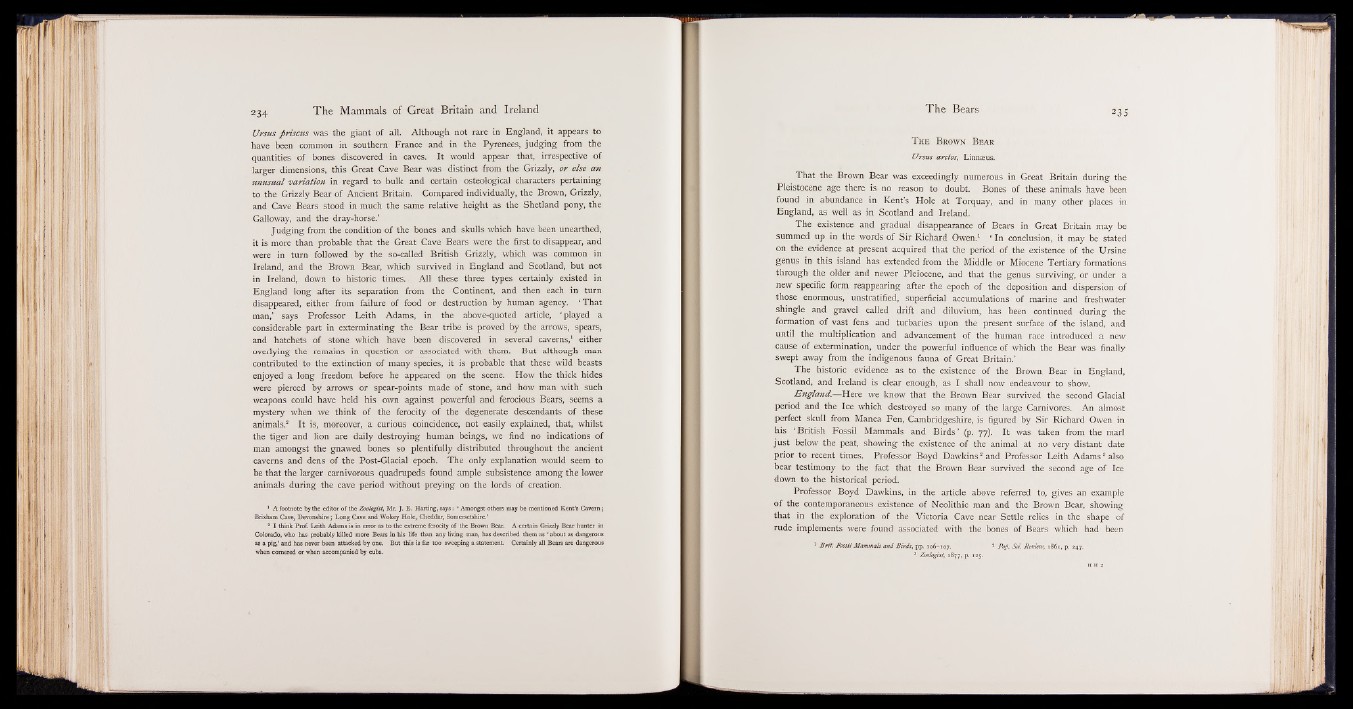
Ursus priscus was the giant of all. Although not rare in England, it appears to
have been common in southern France and in the Pyrenees, judging from the
quantities of bones discovered in caves. It would appear that, irrespective of
larger dimensions, this Great Cave Bear was distinct from the Grizzly, or else an
unusual variation in regard to bulk and certain osteological characters pertaining
to the Grizzly Bear of Ancient Britain. Compared individually, the Brown, Grizzly,
and Cave Bears stood in much the same relative height as the Shetland pony, the
Galloway, and the dray-horse.’
Judging from the condition of the bones and skulls which have been unearthed,
it is more than probable that the Great Cave Bears were the first to disappear, and
were in turn followed by the so-called British Grizzly, which was common in
Ireland, and the Brown Bear, which survived in England and Scotland, but not
in Ireland, down to historic times. All these three types certainly existed in
England long after its separation from the Continent, and then each in turn
disappeared, either from failure of food or destruction by human agency. ‘ That
man,’ says Professor Leith Adams, in the above-quoted article, ‘ played a
considerable part in exterminating the Bear tribe is proved by the arrows, spears,
and hatchets of stone which have been discovered in several caverns,1 either
overlying the remains in question or associated with them. But although man
contributed to the extinction of many species, it is probable that these wild beasts
enjoyed a long freedom before he appeared on the scene. How the thick hides
were pierced by arrows or spear-points made of stone, and how man with such
weapons could have held his own against powerful and ferocious Bears, seems a
mystery when we think of the ferocity of the degenerate descendants of these
animals.2 It is, moreover, a curious coincidence, not easily explained, that, whilst
the tiger and lion are daily destroying human beings, we find no indications of
man amongst the gnawed bones so plentifully distributed throughout the ancient
caverns and dens of the Post-Glacial epoch. The only explanation would seem to
be that the larger carnivorous quadrupeds found ample subsistence among the lower
animals during the cave period without preying on the lords of creation.
1 A footnote by the editor of the Zoologist, Mr. J. E. Harting, says: ‘ Amongst others may be mentioned Kent’s Cavern;
Brixham Cave, Devonshire; Long Cave and Wokey Hole, Cheddar, Somersetshire.’
* I think Prof. Leith Adams is in error as to the extreme ferocity of the Brown Bear. A certain Grizzly Bear hunter in
Colorado, who has probably killed more Bears in his life than any living man, has described them as ‘ about as dangerous
as a pig,’ and has never been attacked by one. But this is far too sweeping a statement. Certainly all Bears are dangerous
when cornered or when accompanied by cubs.
T h e B r o w n B e a r
Ursus arctos, Linnceus.
That the Brown Bear was exceedingly numerous in Great Britain during the
Pleistocene age there is- no reason to doubt. Bones of these animals have been
found in abundance in Kent’s Hole at Torquay, and in many other places in
England, as well as in Scotland and Ireland.
The existence and gradual disappearance of Bears in Great Britain may be
summed up in the words of Sir Richard Owen.1 ‘ In conclusion, it may be stated
on the evidence at present acquired that the period of the existence of the Ursine
genus in this island has extended from the Middle or Miocene Tertiary formations
through the older and newer Pleiocene, and that the genus surviving, or under a
new specific form reappearing after the epoch of the deposition and dispersion of
those enormous, unstratified, superficial accumulations of marine and freshwater
shingle and gravel called drift and diluvium, has been continued during the
formation of vast fens and turbaries upon the present surface of the island, and
until the multiplication and advancement of the human race introduced a new
cause of extermination, under the powerful influence of which the Bear was finally
swept away from the indigenous fauna of Great Britain.’
The historic evidence as to the existence of the Brown, Bear in England,
Scotland, and Ireland is clear enough, as I shall now endeavour to show.
England.— Here we know that the Brown Bear survived the second Glacial
period and the Ice which destroyed so many of the large Carnivores. An almost
perfect skull from Manea Fen, Cambridgeshire, is figured by Sir Richard Owen in
his ‘ British Fossil Mammals and Birds ’ (p. 77). It was taken from the marl
just below the peat, showing the existence of the animal at no very distant date
prior to recent times. Professor Boyd Dawkins2 and Professor Leith Adams8 also
bear testimony to the fact that the Brown Bear survived the second age of Ice
down to the historical period.
Professor Boyd Dawkins, in the article above referred to, gives an example
of the contemporaneous existence of Neolithic man and the Brown Bear, showing
that in the exploration of the Victoria Cave near Settle relics in the shape of
rude implements were found associated with the bones of Bears which had been
1 B rit. Fossil Mammals and Birds, pp. 106-107.
3 Zoologist, 1S.77, p. 125.
a Pop. Sci. Review, 1861, p. 247.